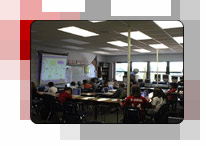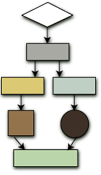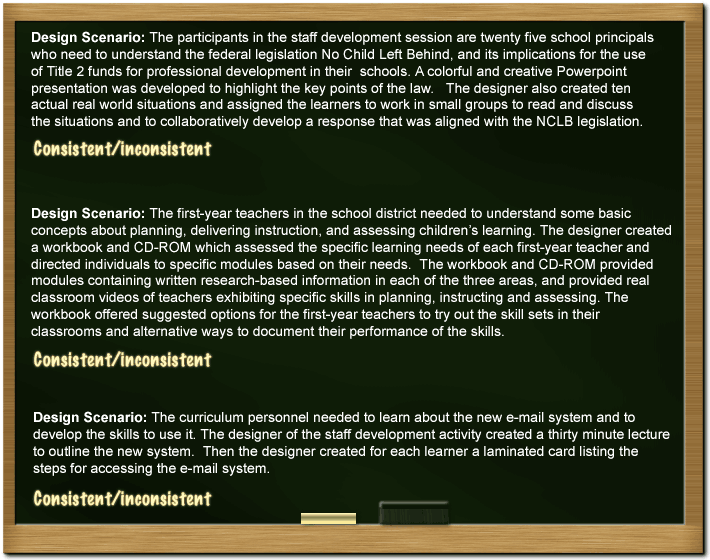- Apply the rationale for change in designing adult learning
- Define the word design as it is used in this course.
- Recognize the steps in the design process.
- Apply adult learning principles to design problems.
- Identify your design project.
Achieving Results
- Are your adult learning experiences producing results?
- Focus on student outcomes requires different staff development approaches.
- Results are a must today!
- What do adults need to know and be able to do?
- Staff development for adults should be linked to student needs.
- Learning should be part of long term plan.
- No more one shot experiences for adult learners.
- What is learned must be transferred and applied to the work setting.
- Staff development must get RESULTS.

![]() Educators
need the opportunity to apply new knowledge in the workplace, to practice
and get feedback when they try out new skills. For real learning to result,
what is learned must be successfully transferred and applied in the work
setting.
Educators
need the opportunity to apply new knowledge in the workplace, to practice
and get feedback when they try out new skills. For real learning to result,
what is learned must be successfully transferred and applied in the work
setting.
How staff development has changed is described in an article that has
become a classic. Print, read, and highlight the key points in the article
A Paradigm Shift in Staff Development Journal of Staff Development,
Fall, 1994 Vol. 15, No. 4, pg. 26
Author: Dennis Sparks ![]()
![]() Submitted
Activity Intro - A: Reflect
and write a brief paragraph response to each of the questions.
Please submit your activity by email to your facilitator. If you
are unable to access email, you may print out the PDF and
fax or
US Mail or Pony Mail
it to your facilitator.
Submitted
Activity Intro - A: Reflect
and write a brief paragraph response to each of the questions.
Please submit your activity by email to your facilitator. If you
are unable to access email, you may print out the PDF and
fax or
US Mail or Pony Mail
it to your facilitator.

To show what you currently do to develop an adult learning experience,
complete the next activity.
![]() Create
a flowchart as a word document illustrating the step-by-step process you
use
for
designing an
adult learning experience or staff development opportunity for which you
have responsibility. Or you may sketch out the process off-line using
paper and colored pencils or markers. Be honest about how you currently
approach designing.
Create
a flowchart as a word document illustrating the step-by-step process you
use
for
designing an
adult learning experience or staff development opportunity for which you
have responsibility. Or you may sketch out the process off-line using
paper and colored pencils or markers. Be honest about how you currently
approach designing.
![]()
Designing Staff Development
| DEFINITION |
| Design is a step-by-step process for the assessment and analysis of learner needs, the development of specific objectives, the development of learning strategies, materials and content, and the evaluation of the effectiveness of the adult learning experience. |
To learn the steps in the design process, review the Flow Chart.
STEPS IN THE DESIGN PROCESS

![]() Please review the
Adult Learning (PDF) presentation.
As we begin to design staff development experiences, these principles
will guide our thinking.
Please review the
Adult Learning (PDF) presentation.
As we begin to design staff development experiences, these principles
will guide our thinking.
To gain more insight about adult learning, you may consult additional
resources. For additional information about Adult Learning, you may choose
to read one of the following “classics” in adult education.
Resources:
- Brookfield, S.D. (1986) Understanding and facilitating adult learning.
San Francisco: Jossey Bass - Knowles, M.S. (1998) The modern practice of adult education: From
pedagogy to andragogy. Englewood Cliffs, NJ: Prentice-Hall - Merriam, S.B.,& Caffarella, R.S. (1991). Learning in adulthood.
San
Francisco: Jossey-Bass.
If you were able to answer the questions correctly, continue with the module. If you were not, go back and review the Adult Learning (PDF) presentation and select additional resources on adult learning to expand your understanding. If you would like to print the PDF, simply click on the PDF link and print the document.
The Broward County Schools approach to designing quality staff development is aligned with the best available knowledge at the national, state and, local levels. To understand more about the rationale for the changes, explore the national, state and local district policies driving the changes in the design and delivery of staff development in the school district. Each link will take you to more information. Be prepared to discuss these national, state, and local policies at the first study group meeting.
Resources:
The National Staff Development Council has developed twelve Standards for Staff Development relating to context, content, and process.
PDF: The State of Florida has developed a Protocol System for Evaluating Professional Development
PDF: The Broward County School District "Pathways Policy" directs staff development in the district to include the national and state standards of effective professional development.
PDF: The Broward County Staff Development Model addresses all the components necessary for effective staff development and ensures “change” takes place. The model is also linked to the Sterling Criteria used in the district.
A video-tape based program titled, A Paradigm Shift: Staff Development for Improved Learning is available for check out from the Myron Ashmore Center in Broward County Schools HRD Department. This program is produced by Video Journal. This video provides additional rationale for the shift to results-driven, impact focused staff development approaches and examples of what is happening in other districts around the country.
To identify your project, think about a “real world” learning experience you need to design or re-design. As you proceed through this course, you will demonstrate your learning by preparing pieces of the design you have identified. For now, you will simply identify your design project and e-mail it to your learning facilitator. At the first study group meeting be prepared to share a preview of your design project. You will receive helpful feedback from your learning facilitator and peers.
![]() Submitted
Activity Intro - B: Please submit your activity by email
to your facilitator. If you are unable to access email, you may print
out the
PDF and fax or
US Mail or Pony Mail
it to your
facilitator.
Submitted
Activity Intro - B: Please submit your activity by email
to your facilitator. If you are unable to access email, you may print
out the
PDF and fax or
US Mail or Pony Mail
it to your
facilitator.
YOUR DESIGN PROJECT

